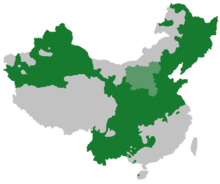Mandarin Chinese language
| Mandarin | |
|---|---|
| 官话; 官話; Guānhuà | |

Guānhuà (Mandarin)
written in Chinese characters (traditional Chinese on the left, simplified Chinese on the right) |
|
| Region | Most of northern and southwestern China (see also Standard Chinese) |
|
Native speakers
|
960 million (2010) |
|
Early forms
|
Old Chinese
|
|
Standard forms
|
Standard Chinese
(Putonghua, Guoyu) |
| Dialects |
|
|
Traditional Chinese Simplified Chinese Cyrillic (Dungan alphabet) Xiao'erjing Mainland Chinese Braille Taiwanese Braille Two-Cell Chinese Braille Pinyin Zhuyin |
|
| Wenfa Shouyu | |
| Language codes | |
| ISO 639-3 | |
| Glottolog | mand1415 |
| Linguasphere | 79-AAA-b |

Mandarin area in China, with Jin (sometimes treated as a separate group) in light green
|
|
| Mandarin Chinese | |||||||
| Traditional Chinese | |||||||
|---|---|---|---|---|---|---|---|
| Simplified Chinese | 官话 | ||||||
| Literal meaning | officials' speech | ||||||
|
|||||||
| Northern Chinese | |||||||
| Chinese | 北方話 | ||||||
| Literal meaning | Northern speech | ||||||
|
|||||||
| Transcriptions | |
|---|---|
| Standard Mandarin | |
| Hanyu Pinyin | Guānhuà |
| Transcriptions | |
|---|---|
| Standard Mandarin | |
| Hanyu Pinyin | Běifānghuà |
Mandarin (![]() i/ˈmændərɪn, -drɪn/; simplified Chinese: ; traditional Chinese: ; pinyin: Guānhuà; literally: "speech of officials") is a group of related varieties of Chinese spoken across most of northern and southwestern China. The group includes the Beijing dialect, the basis of Standard Mandarin or Standard Chinese. Because most Mandarin dialects are found in the north, the group is sometimes referred to as the Northern dialects (北方话; běifānghuà). Many local Mandarin varieties are not mutually intelligible. Nevertheless, Mandarin is often placed first in any list of languages by number of native speakers (with nearly a billion).
i/ˈmændərɪn, -drɪn/; simplified Chinese: ; traditional Chinese: ; pinyin: Guānhuà; literally: "speech of officials") is a group of related varieties of Chinese spoken across most of northern and southwestern China. The group includes the Beijing dialect, the basis of Standard Mandarin or Standard Chinese. Because most Mandarin dialects are found in the north, the group is sometimes referred to as the Northern dialects (北方话; běifānghuà). Many local Mandarin varieties are not mutually intelligible. Nevertheless, Mandarin is often placed first in any list of languages by number of native speakers (with nearly a billion).
...
Wikipedia
